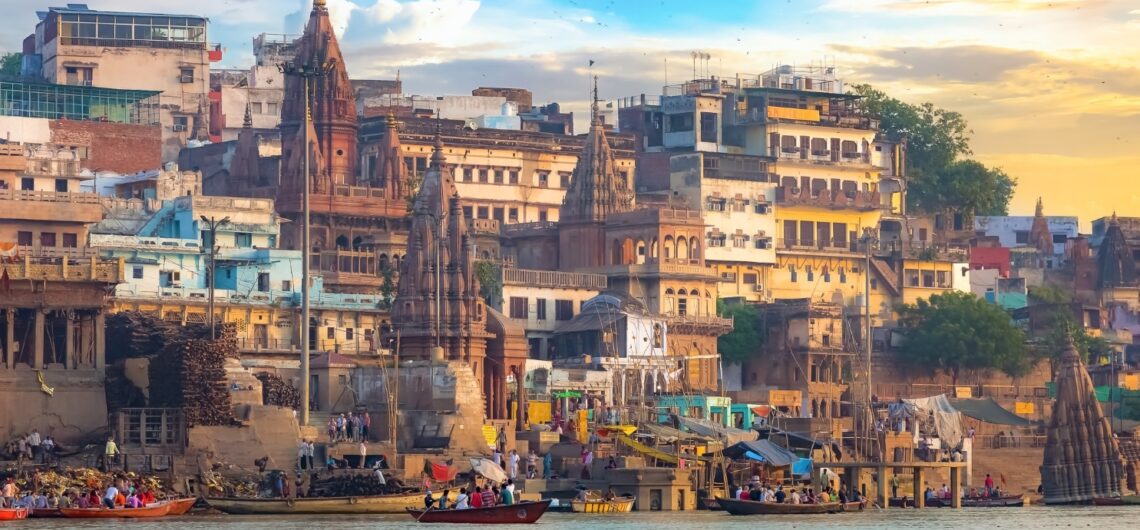
Overview of Varanasi Old City
Varanasi Old City One of the world’s oldest cities still in continuous habitation, Varanasi is the spiritual and cultural center of India. It seems like a trip back in time to wander through the Old City of Varanasi’s winding lanes. Every corner reveals a historical, devotional, and traditional tale. From bustling markets to ancient temples, and from hidden alleys to sacred ghats, the city provides an unmatched tour through India’s rich cultural legacy. This article will take you on a heritage walk through the Varanasi Old City, where you can discover its architectural wonders, holy sites, and cultural importance.
The Varanasi Old City Significance
The significance of spirituality
India’s spiritual capital is Varanasi, sometimes referred to as Kashi or Banaras. It is thought to be the city where death and life meet. Hindus travel from all over the world to this place to complete rituals, bathe in the Ganges River’s sacred waters, and pursue spiritual enlightenment. The center of this spiritual journey continues to be the Varanasi Old City, with its high concentration of temples and holy locations.
A Combination of Culture and History
Varanasi Old City is a synthesis of religion, culture, and history. Its narrow lanes, ancient buildings, and vibrant bazaars reflect the city’s 3,000-year history. Varanasi Old City has been a hub for education, music, and the arts from the Mughal era to the present. This heritage walk takes you on a journey through the changing face of Indian culture.
Beginning at Assi Ghat
The Ghat at the Southernmost Point
Assi Ghat, one of Varanasi’s most well-known and southernmost ghats, is where our journey starts. Assi Ghat is where locals and visitors congregate for morning prayers and evening aartis (prayers), despite being more tranquil than the busy main ghats. This location offers a breathtaking sunrise view of the Ganges, which is glowing orange and gold.
What Makes Assi Ghat Unique
Because it is thought that Lord Shiva rested here after defeating the demon Shumbha-Nishumbha, Assi Ghat has great spiritual significance. In addition to offering prayers at the adjacent Shiva Lingam beneath a peepal tree, pilgrims travel to Assi Ghat to dip in the Ganges. This area’s serene atmosphere sets the tone for the remainder of your stroll.
Investigating the Ghats
Dashashwamedh Ghat: Varanasi’s beating heart
The liveliest and most famous ghat in Varanasi is Dashashwamedh Ghat, which you will eventually arrive at as you stroll north along the Ganges. Every evening, this location hosts the well-known Ganga Aarti, which attracts people from all over the world. Witnessing priests carry out rituals, chant prayers, and wave lamps in a rhythmic harmony is a sight to behold.
An Opening to Moksha at Manikarnika Ghat
If you proceed, you will eventually reach Manikarnika Ghat, the most important Hindu cemetery. Being cremated here is thought to guarantee moksha, or freedom from the cycle of reincarnation. Seeing the funeral rites may seem overwhelming, but they serve as a moving reminder of the Hindu belief system’s central theme—the cycle of life and death.
Another Sacred Cremation Ghat is Harishchandra Ghat.
Similar to Manikarnika Ghat, Harishchandra Ghat is also a significant ghat and is used as a cremation site. Legend has it that King Harishchandra, who was renowned for his unwavering honesty, served in this capacity in order to carry out a divine promise. This ghat has great mythological significance and is named in his honor.
Varanasi Old City Temples
Kashi Vishwanath Temple: The Center of Spirituality
The Kashi Vishwanath Temple, devoted to Lord Shiva, is a must-see destination in Varanasi. This temple is regarded as Varanasi’s spiritual center and is one of the twelve Jyotirlingas, the holiest shrines dedicated to Shiva. Even though the original building was demolished and then rebuilt multiple times, the current temple is a magnificent example of North Indian temple architecture. This is a must-see location because of the exquisite carvings, the gold-plated spires, and the overwhelming sense of devotion.
Annapurna Temple: The Feeble Goddess
Adjacent to Kashi Vishwanath is the Annapurna Temple, honoring the goddess of sustenance and food. Since Annapurna is thought to be a manifestation of Goddess Parvati, people pray to her for wealth and prosperity. Even though it’s not as busy as Kashi Vishwanath, devotees still place great importance on the temple.
Kal Bhairav Temple: Varanasi Old City Hardy Defender
The Kal Bhairav Temple, devoted to Lord Shiva’s ferocious form, is a short stroll away. Believers of Bhairav hold that he is Varanasi’s guardian deity and that no one can enter the city without his consent. The atmosphere in the temple is intense as worshippers light oil lamps and offer prayers in hopes of obtaining Bhairav’s protection.
Secret Treasures in Varanasi Old City
Nepali Temple in Varanasi: A Hint of Nepal
The Nepali Temple, which is close to Lalita Ghat, is one of Varanasi’s hidden architectural gems. The Nepalese King erected this pagoda-style temple in honor of Lord Shiva during the 1800s. The temple is renowned for its elaborate woodwork, which is reminiscent of Nepalese craftsmanship. It stands out from the other temples in Varanasi due to its distinctive architecture.
Raja Ghat and The Ancient Mansion
Raja Ghat, a location that is frequently disregarded, leads to the ruins of a magnificent palace constructed by a Maharaja. Despite its disrepair, the palace provides an insight into Varanasi’s royal past and the aristocratic lifestyle. The less crowded ghat itself provides a tranquil escape from the bustle of the more well-known ghats.
Strolling Through the Old City’s Alleys
The Narrow Lanes: A Historical Maze
The Old City of Varanasi’s maze-like system of tiny lanes, or galis, is one of its most fascinating features. There are numerous hidden temples, historic homes, and active marketplaces along these lanes. Little shrines tucked away in corners, vibrant stores selling everything from spices to silk sarees, and locals going about their everyday business can all be seen as you meander through these alleys.
Vishwanath Gali: An Ideal Place for Shoppers
To bring back a memento of Varanasi, visit Vishwanath Gali, a busy marketplace that is located close to the Kashi Vishwanath Temple. Traditional Banarasi sarees, jewelry made by hand, brass idols, and other mementos are available here. Shopkeepers invite you to peruse their wares, and the market’s lively energy is contagious.
Thatheri Bazaar: An Overview of Customary Handicrafts
The Thatheri Bazaar, which is near Vishwanath Gali, is where craftspeople create antique brass and copper utensils using techniques that have been handed down through the years. This area of the Old City provides a glimpse into the artisanship for which Varanasi is known, and you can even buy handcrafted goods to take home as a keepsake from your heritage tour.
Street Food Delights in Varanasi
Kachori and Jalebi: A Custom of the Morning
Enjoying the street food of Varanasi is a must-do while strolling around the city. Kachori and jalebi is a popular breakfast combo in Varanasi. Start your day with it. Deep-fried bread filled with spiced lentils and served with a tart potato curry is called kachori. The crispy, syrup-drenched dessert known as jalebi counterbalances the savory kachori.
Banarasi Paan: The Ultimate Immersion
A betel leaf filled with areca nut, sweet chutneys, and spices is called Banarasi paan. Try it after a filling meal or simply to cleanse your palate. A staple of Varanasi culture, pan is frequently consumed as a mouth freshener and digestive after meals.
Finishing Your Heritage Stroll
The Old City of Varanasi’s Timeless Charm
An exploration of the timeless essence of India is what a heritage walk through Varanasi’s Old City entails, rather than just a trip through lanes and ghats. The city offers an experience unlike any other because of its spiritual energy, rich historical legacy, and vibrant cultural scene. You’ll be taken to a place where tradition and modernity live in harmony as you stroll through its historic streets.
FAQs
When is the ideal time to visit the Varanasi Old City?
The cooler months of October through March are the ideal times to visit because the weather is nice enough for strolling.
Does Varanasi offer guided walks through its heritage?
Yes, a number of local businesses provide informative commentary on the history, culture, and architecture of the city during their guided heritage walks.
Is it safe to stroll the Varanasi Old City by yourself?
Absolutely, it’s safe to visit the Varanasi Old City alone, but you should still be cautious in the congested lanes and watch out for your belongings.
What attire is appropriate for the heritage walk?
Given that Varanasi Old City is a spiritual city, modest clothing is appropriate. It’s also advisable to wear comfortable walking shoes to navigate the ghats and small lanes.
How much time does a typical Varanasi heritage walk take?
Depending on your pace and the locations you want to visit, a heritage walk can take two to four hours.
When is the best time to go to Varanasi Old City?
The best months to go are October through March, when the temperature is comfortable enough for strolling.
Does Varanasi provide heritage walks with guides?
Yes, during their guided heritage walks, several local businesses offer insightful commentary on the city’s history, culture, and architecture.
Is it okay to take a solo stroll through the Varanasi Old City?
Yes, it is safe to explore the Varanasi Old City on your own, but you should still exercise caution in the crowded lanes and keep an eye out for your personal belongings.
What kind of clothing is suitable for the historical walk?
Modest attire is appropriate in Varanasi Old City, as it is a spiritual city. Wearing comfortable walking shoes is also recommended for navigating the narrow lanes and ghats.
What is the average duration of a heritage walk in Varanasi Old City?
A heritage walk can take two to four hours, depending on your pace and the places you wish to see.


Comments